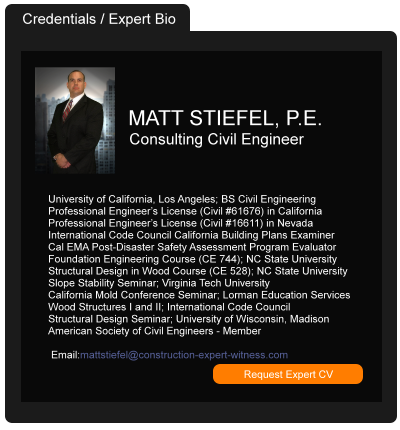Insurer’s Motion for Summary Judgment Based on Earth Movement Exclusion Denied
October 28, 2011 —
Tred R. Eyerly - Insurance Law HawaiiAfter carefully dissecting the earth movement exclusion, the court denied the insurer’s motion for summary judgment. High Street Lofts Condominium Assoc., Inc. v. Am. Family Mut. Ins. Co., 2011 U.S. Dist. LEXIS 109043 (D. Colo. Sept. 26, 2011).
The City of Boulder performed road repair work near High Street’s property, some of which involved the use of a vibrating compactor to compact and set the roadbed. High Street noticed damage to its building, such as cracks in walls, sloping of floors and separations of porches from the building itself. High Street contacted the City of Boulder, who forwarded the complaint to its contractor, Concrete Express, Inc.
High Street also filed a claim with its business insurer, American Family, who denied the claim. American Family relied on an opinion letter by High Street’s engineer. The letter indicated that the damage was the result of "soil consolidation/settlement," in response to the construction activities. Based on this letter American Family concluded the claim was excluded under the policy’s earth movement exclusion.
High Street sued American Family, who moved for summary judgment.
Read the full story...
Reprinted courtesy of Tred R. Eyerly, Insurance Law Hawaii. Mr. Eyerly can be contacted at te@hawaiilawyer.com
Read the court decisionRead the full story...Reprinted courtesy of
Colorado homebuilders target low-income buyers with bogus "affordable housing" bill
March 05, 2015 —
Jesse Howard Witt – Acerbic Witt“Affordable housing” is the latest catchphrase for Colorado homebuilders seeking immunity from warranty claims and repair requests.
In 2013, the homebuilders’ lobby said it was about public transportation. In 2014 they said it was about community building. Now it’s 2015, and the lobbyists are claiming that a lack of affordable housing is the reason why politicians should eliminate consumer protections for homebuyers.
The Colorado Senate recently announced the introduction of SB 15-177. If passed, the bill will make it illegal for homeowner associations to hire construction experts or lawyers unless they can first satisfy a complicated disclosure and voting process. Although sponsors portray the bill as an innocuous measure that merely requires more community involvement, its provisions have actually been tailored to take advantage of recent court decisions that make it difficult for homeowner associations to vote on measures outside of a meeting or act quickly to resolve construction defect disputes. The intent is to make it nearly impossible for homeowners to retain construction experts or legal representation before the statute of limitations period expires, thereby making homebuilders immune from any potential claims. The bill will also eliminate the right to a jury trial in many cases, forcing any disputes that overcome the procedural hurdles into costly, private arbitration proceedings. The sponsors argue that these measures are necessary to encourage builders to erect more cheap condominiums.
Read the court decisionRead the full story...Reprinted courtesy of
Jesse Howard Witt, The Witt Law FirmMr. Witt welcomes comments at www.acerbicwitt.com
California’s Housing Costs Endanger Growth, Analyst Says
March 19, 2015 —
John Gittelsohn – Bloomberg(Bloomberg) -- California’s high housing costs threaten the state’s economy as workers increasingly struggle to afford a roof over their heads, the state Legislative Analyst’s Office said in a report released Tuesday.
“The state’s high housing costs make California a less attractive place to call home, making it more difficult for companies to hire and retain qualified employees, likely preventing the state’s economy from meeting its full potential,” Chas Alamo and Brian Uhler, senior fiscal and policy analysts with the office, said in the study.
California was home to four of the five most expensive U.S. metropolitan markets for single-family home sales in the fourth quarter of last year, led by a median home price of $855,000 in the San Jose, Sunnyvale and Santa Clara area, according to the National Association of Realtors. San Francisco ranked second, with Honolulu and the California cities of Anaheim and San Diego rounding out the top five. The suburbs north of New York City and greater Los Angeles followed.
Read the court decisionRead the full story...Reprinted courtesy of
John Gittelsohn, BloombergMr. Gittelsohn may be contacted at
johngitt@bloomberg.net
Record Keeping—the Devil’s in the Details
July 30, 2015 —
Craig Martin – Construction Contract AdvisorAnother court has found that poor record keeping will prevent recovery on a claim. The court in Weatherproofing Tech., Inc. v. Alacran Contracting, LLC found that a contractor’s documents were a mess and that no reasonable jury could base a verdict on the contractor’s records.
The underlying project involved the construction of an army training facility. The total project cost approximated $13 million. Alacran, the general contractor, subcontracted about $3 million of the work to Weatherproofing Tech. Alacran paid Weatherproofing $700,000 for its work, even though Weatherproofing submitted invoices of more than $2 million. Alacran justified its refusal to pay Weatherproofing on the grounds that the parties had agreed to split the profit and loss on the project and the project was out of money. Not surprisingly, Weatherproofing sued Alacran for the amount owed.
Read the court decisionRead the full story...Reprinted courtesy of
Craig Martin, Lamson, Dugan and Murray, LLPMr. Martin may be contacted at
cmartin@ldmlaw.com
Homeowner’s Policy Excludes Coverage for Loss Caused by Chinese Drywall
November 18, 2011 —
Tred R. Eyerly - Insurance Law HawaiiExclusions barred the homeowners from recovering for losses caused by Chinese drywall in their home. Ross v. C. Adams Const. & Design, L.L.C., 2011 La. App. LEXIS 769 (La. Ct. App., released for publication Oct. 5, 2011).
Two years after purchasing their home, the Rosses began experiencing chronic malfunctions in the heating, ventilation and air conditioning system. After discovering the presence of gypsum drywall, or "Chinese drywall", they submitted a claim to their insurer, Louisiana Citizens Property Insurance Company, for damages caused by the Chinese drywall. Louisiana Citizens denied the claim.
The Rosses sued. The trial court granted summary judgment to Louisiana Citizens based upon exclusions in the policy.
On appeal, the appellate court first agreed the Rosses had sustained a direct physical loss. The inherent qualities of the Chinese drywall created a physical loss to the home and the drywall had to be removed and replaced.
Read the full story…
Reprinted courtesy of Tred R. Eyerly, Insurance Law Hawaii. Mr. Eyerly can be contacted at te@hawaiilawyer.com
Read the court decisionRead the full story...Reprinted courtesy of
If I Released My California Mechanics Lien, Can I File a New Mechanics Lien on the Same Project? Will the New Mechanics Lien be Enforceable?
December 29, 2020 —
William L. Porter - Porter Law GroupIf I Released My California Mechanics Lien, Can I File a New Mechanics Lien on the Same Project? Will the New Mechanics Lien be Enforceable?
In general, the answer to the above questions is “Yes”, but only if you meet the following requirements:
- You must only release the mechanics lien itself, but not the “right” to a mechanics lien: There is an important distinction to be made between releasing a mechanics lien and releasing the right to a mechanics lien. Whether you do one or the other will depend on the specific language used in your release. In the case of Santa Clara Land Title Co. v. Nowack and Associates, Inc. (1991) 226 Cal. App.3d, 1558 a “release of mechanics lien” document was recorded TO THE County Recorder’s office which included a statement that the mechanics lien was “fully satisfied, released and discharged”. Based on this language, the court concluded that the mechanics lien claimant had waived its “right” to a further mechanics lien on the same property for the work in question. The court concluded that since the release stated that the claim was “fully satisfied” the right to mechanics lien on the project had forever been waived. The Nowak case can be distinguished from the case of Koudmani v. Ogle Enterprises, Inc., (1996) 47 Cal.App.4th 1650, where the release of mechanics lien only stated that the mechanics lien was “otherwise released and discharged” and not that it was “satisfied”. Based on the distinction drawn from the two cases, a simple mechanics lien release that only releases the mechanics lien itself, but not the “right” to a mechanics lien should be used. At the following link you will find a proper form to achieve this purpose: https://www.porterlaw.com/wp-content/uploads/2019/06/03PRI-Mechanics-Lien-Release.pdf
Read the court decisionRead the full story...Reprinted courtesy of
William L. Porter, Porter Law GroupMr. Porter may be contacted at
bporter@porterlaw.com
First Lumber, Now Drywall as Canada-U.S. Trade Tensions Escalate
November 30, 2016 —
Katia Dmitrieva – BloombergA new trade dispute has broken out between Canada and the U.S. that threatens to raise prices in Canada’s already overheated housing markets.
The Canada Border Services Agency imposed a provisional tariff as high as 277 percent on U.S. drywall imports in September after ruling that manufacturers were dumping the product, or selling it below the price in their home market, undercutting local suppliers.
The tariff has raised the price of drywall, or gypsum board as it’s also called, by as much as 30 percent and is causing “chaos” and delays as contractors scramble for alternative sources. Some builders say the tariff could add as much as C$13,000 ($9,671) to the cost of a new home, which would amount to a C$2.6 billion increase to the roughly 200,000 homes built in Canada each year.
Read the court decisionRead the full story...Reprinted courtesy of
Katie Dmitrieva, BloombergMs. Dmitrieva may be followed on Twitter @katiadmi
Sacramento Water Works Recognized as a Historic Civil Engineering Landmark
October 03, 2022 —
The American Society of Civil EngineersRESTON, Va. – The American Society of Civil Engineers (ASCE) Sacramento Section today recognized the City of Sacramento Water Works a Historic Civil Engineering Landmark. The landmark, which was completed in 1854, was recognized at a dedication ceremony at the Sacramento History Museum led by ASCE's Sacramento Section, which is celebrating its centennial anniversary of the Section's founding. The section was joined by Ken Rosenfield, director, ASCE Region 9 and Chuck Spinks, chair, Region 9 History and Heritage Committee.
ASCE represents more than 150,000 members of the civil engineering profession worldwide. It is the oldest national engineering society in the United States. ASCE recognizes historically significant civil engineering projects, structures, and sites all over the world. More than 280 projects have earned the prestigious title for creativity and innovation, and almost all are executed under challenging conditions.
The City of Sacramento Water Works was the first municipal, city-owned water system west of the Mississippi River. This project was inspired by a disastrous fire in 1852 that destroyed 27 blocks in Sacramento and the city did not have a water system capable of putting out fires. The water works site was equipped with a distribution system with hydrants that could fight fires.
The City of Sacramento Water Works was nominated by the ASCE Sacramento Section Centennial Committee. For more information about ASCE's Historic Civil Engineering Landmark Program, go to https://www.asce.org/about-civil-engineering/history-and-heritage/historic-landmarks.
ABOUT THE AMERICAN SOCIETY OF CIVIL ENGINEERS
Founded in 1852, the American Society of Civil Engineers represents more than 150,000 civil engineers worldwide and is America's oldest national engineering society. ASCE works to raise awareness of the need to maintain and modernize the nation's infrastructure using sustainable and resilient practices, advocates for increasing and optimizing investment in infrastructure, and improve engineering knowledge and competency. For more information, visit www.asce.org or www.infrastructurereportcard.org and follow us on Twitter, @ASCETweets and @ASCEGovRel.
Read the court decisionRead the full story...Reprinted courtesy of


































































